Environmental Impact Assessment Assignment: QLD, NSW Comparison
VerifiedAdded on 2023/02/01
|20
|4007
|83
Report
AI Summary
This report examines sustainable systems and Environmental Impact Assessments (EIA). It begins by revisiting the concept of "Limits to Growth" and how Australia addresses resource depletion through renewable energy promotion, pollution reduction, and family planning. The report then compares the EIA project approval processes in Queensland (QLD) and New South Wales (NSW), highlighting key differences in scoping, application, community involvement, and assessment timelines. It also discusses the importance of public participation in the EIA process, emphasizing its role in conflict reduction, data generation, and improved project understanding. The report further presents a case study of a proposed methanol factory, detailing the EIA steps followed, from screening and scoping to impact prediction and mitigation. The report concludes by summarizing the project approval process, the importance of public participation, and the EIA process.
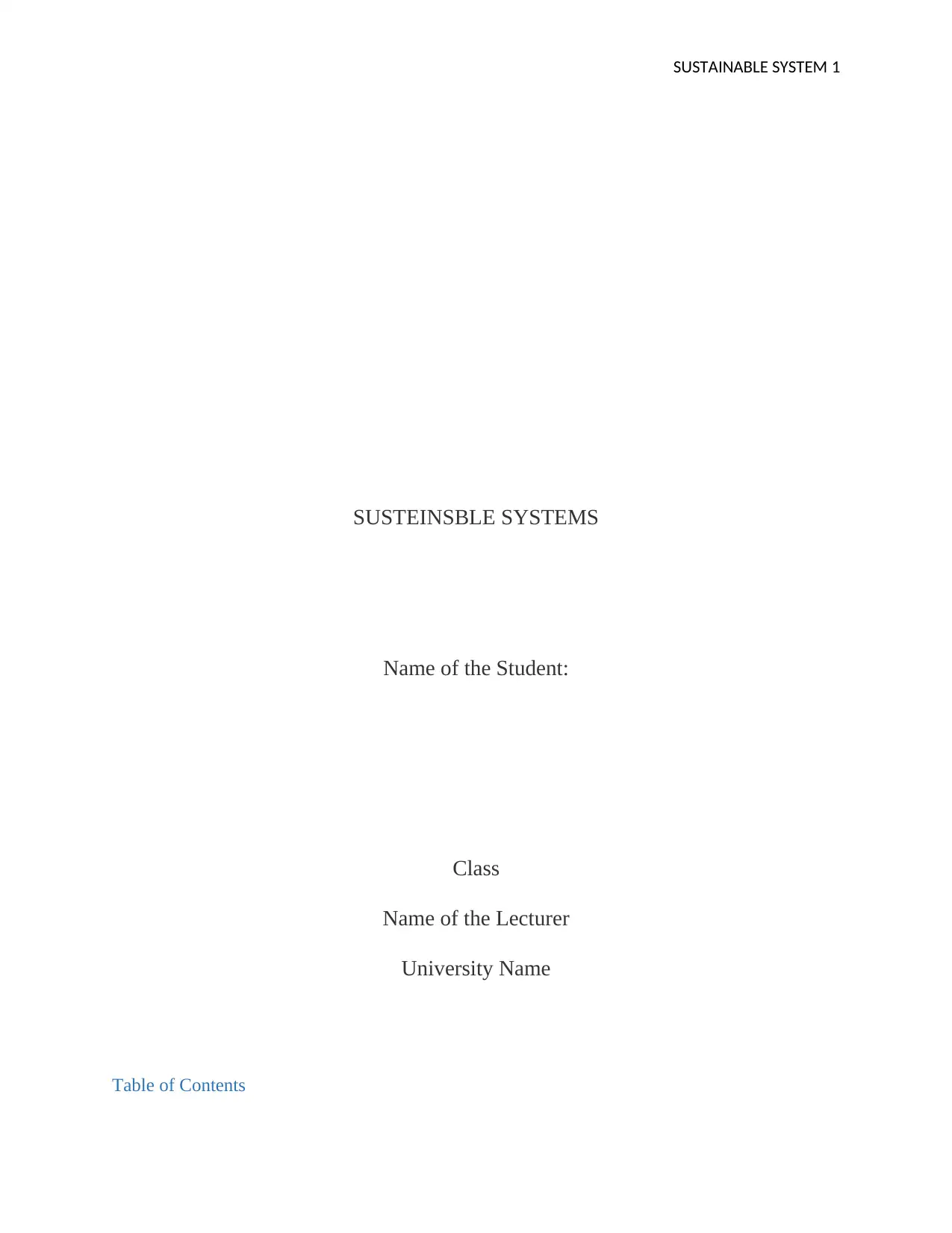
SUSTAINABLE SYSTEM 1
SUSTEINSBLE SYSTEMS
Name of the Student:
Class
Name of the Lecturer
University Name
Table of Contents
SUSTEINSBLE SYSTEMS
Name of the Student:
Class
Name of the Lecturer
University Name
Table of Contents
Paraphrase This Document
Need a fresh take? Get an instant paraphrase of this document with our AI Paraphraser
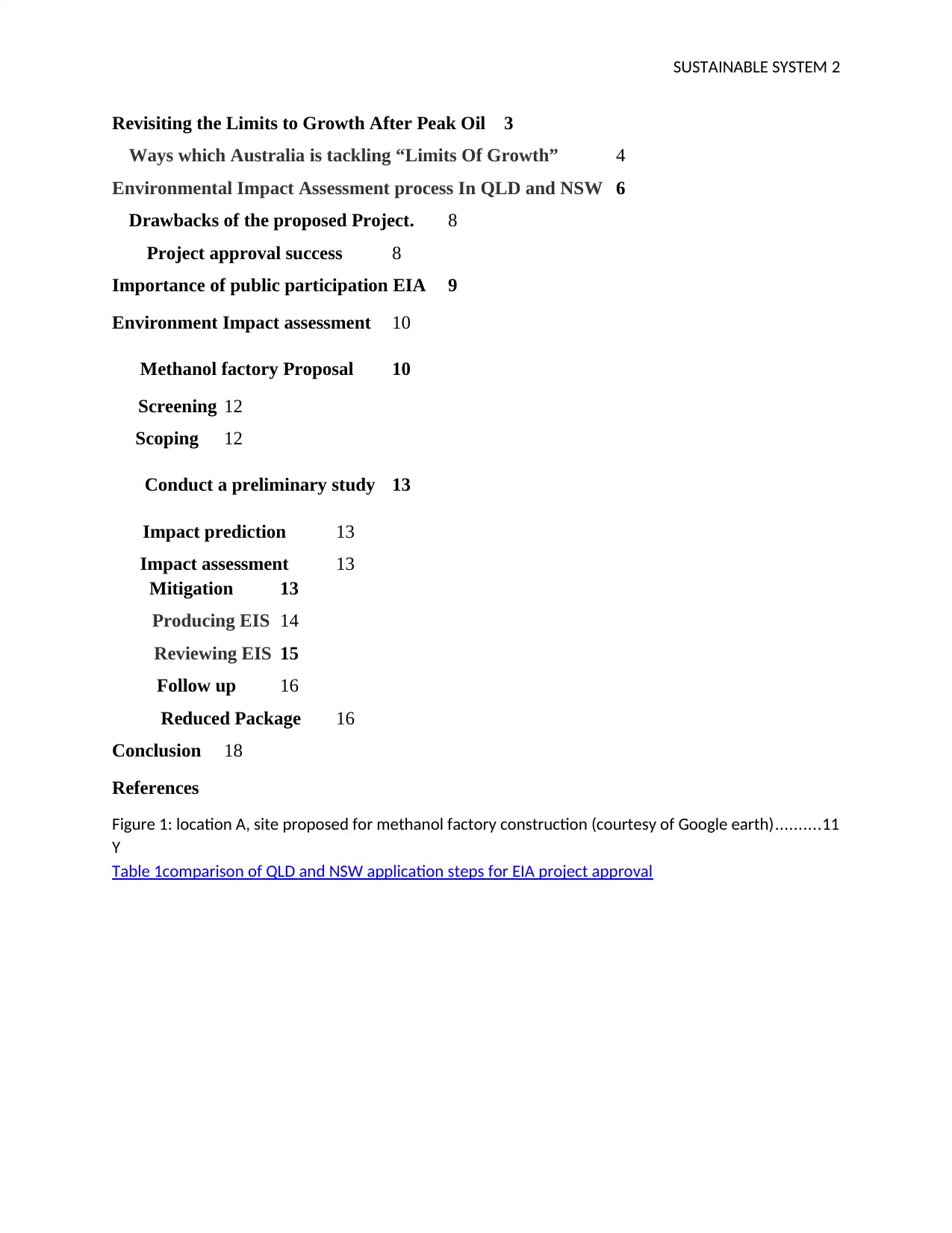
SUSTAINABLE SYSTEM 2
Revisiting the Limits to Growth After Peak Oil 3
Ways which Australia is tackling “Limits Of Growth” 4
Environmental Impact Assessment process In QLD and NSW 6
Drawbacks of the proposed Project. 8
Project approval success 8
Importance of public participation EIA 9
Environment Impact assessment 10
Methanol factory Proposal 10
Screening 12
Scoping 12
Conduct a preliminary study 13
Impact prediction 13
Impact assessment 13
Mitigation 13
Producing EIS 14
Reviewing EIS 15
Follow up 16
Reduced Package 16
Conclusion 18
References
Figure 1: location A, site proposed for methanol factory construction (courtesy of Google earth)..........11
Y
Table 1comparison of QLD and NSW application steps for EIA project approval
Revisiting the Limits to Growth After Peak Oil 3
Ways which Australia is tackling “Limits Of Growth” 4
Environmental Impact Assessment process In QLD and NSW 6
Drawbacks of the proposed Project. 8
Project approval success 8
Importance of public participation EIA 9
Environment Impact assessment 10
Methanol factory Proposal 10
Screening 12
Scoping 12
Conduct a preliminary study 13
Impact prediction 13
Impact assessment 13
Mitigation 13
Producing EIS 14
Reviewing EIS 15
Follow up 16
Reduced Package 16
Conclusion 18
References
Figure 1: location A, site proposed for methanol factory construction (courtesy of Google earth)..........11
Y
Table 1comparison of QLD and NSW application steps for EIA project approval
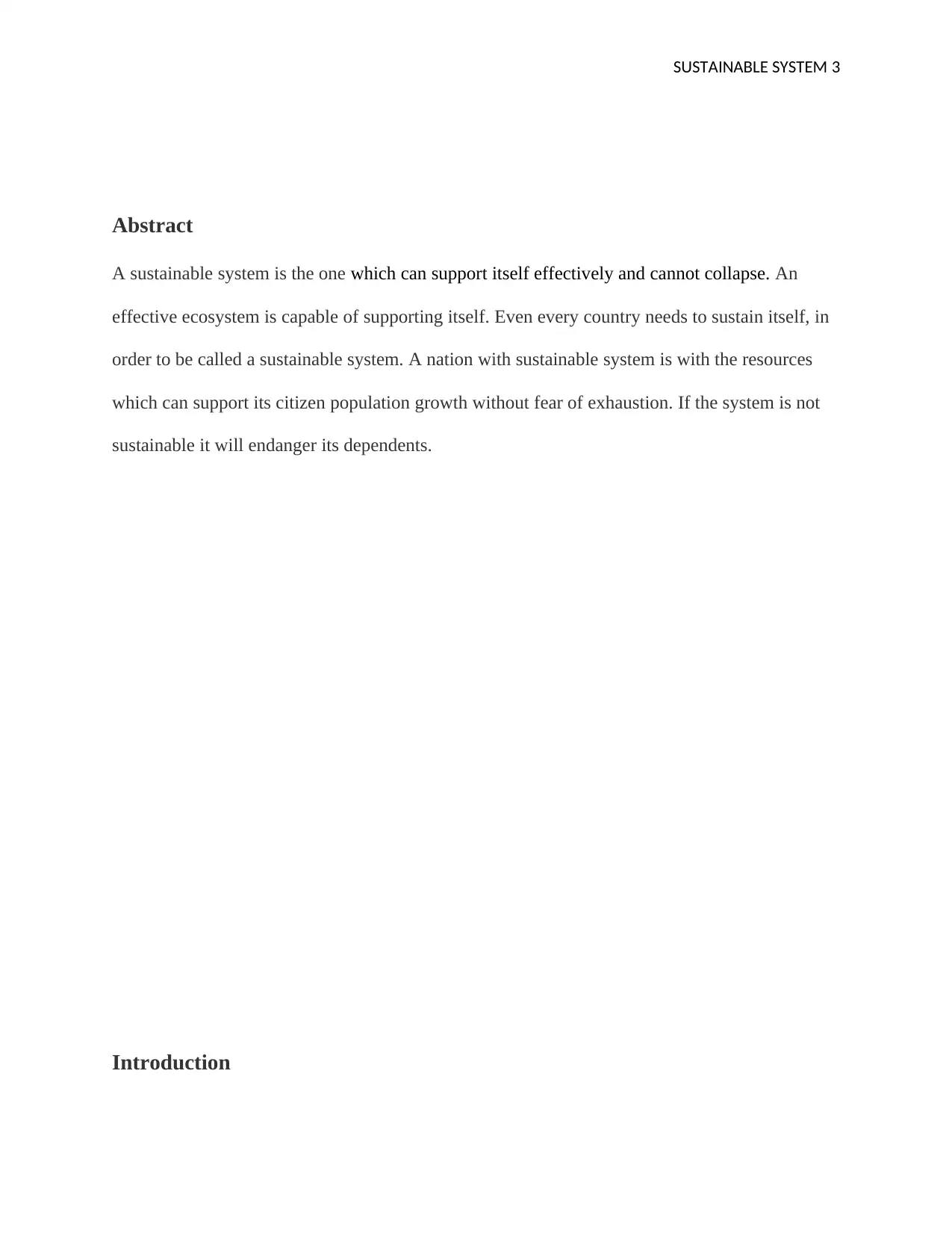
SUSTAINABLE SYSTEM 3
Abstract
A sustainable system is the one which can support itself effectively and cannot collapse. An
effective ecosystem is capable of supporting itself. Even every country needs to sustain itself, in
order to be called a sustainable system. A nation with sustainable system is with the resources
which can support its citizen population growth without fear of exhaustion. If the system is not
sustainable it will endanger its dependents.
Introduction
Abstract
A sustainable system is the one which can support itself effectively and cannot collapse. An
effective ecosystem is capable of supporting itself. Even every country needs to sustain itself, in
order to be called a sustainable system. A nation with sustainable system is with the resources
which can support its citizen population growth without fear of exhaustion. If the system is not
sustainable it will endanger its dependents.
Introduction
⊘ This is a preview!⊘
Do you want full access?
Subscribe today to unlock all pages.

Trusted by 1+ million students worldwide
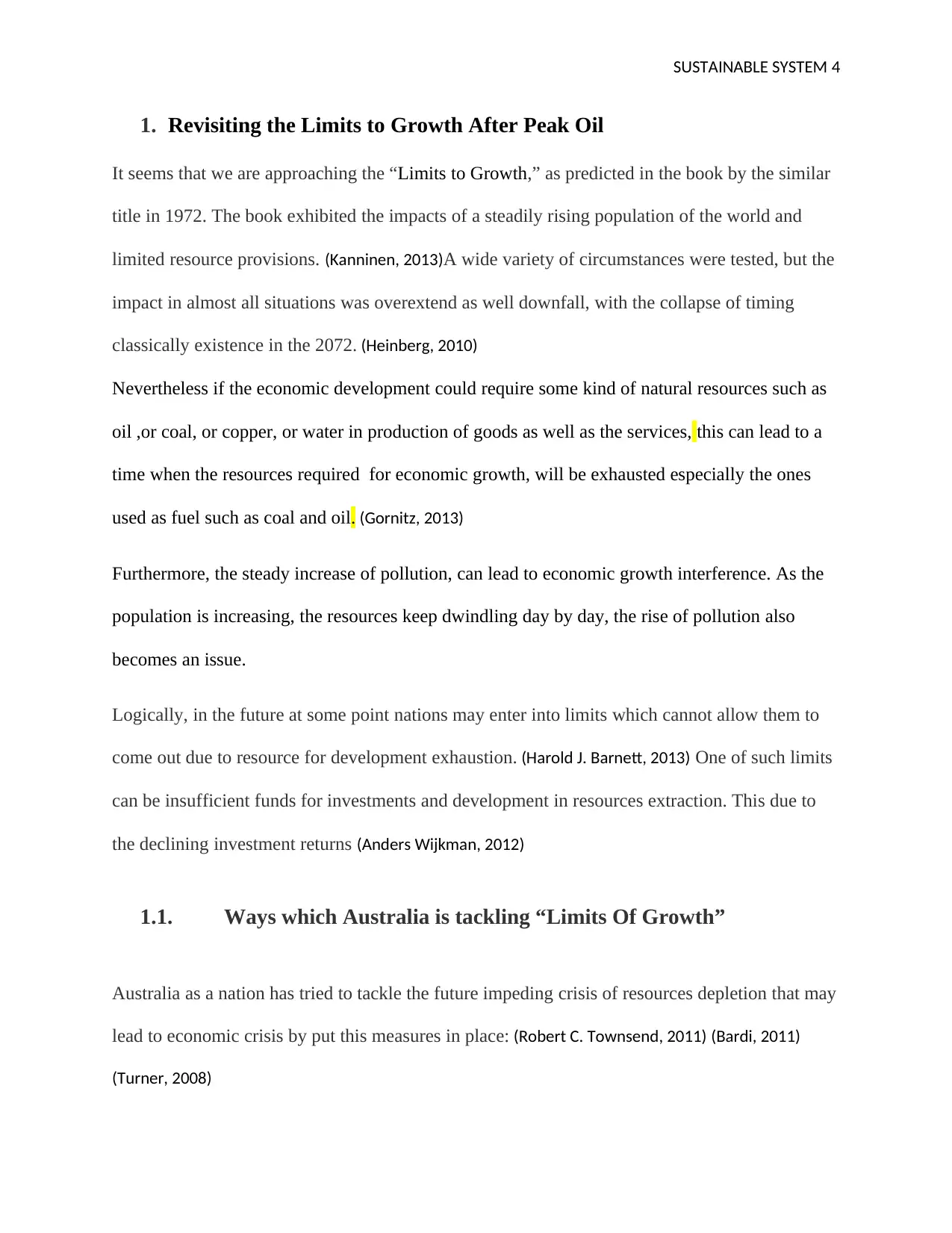
SUSTAINABLE SYSTEM 4
1. Revisiting the Limits to Growth After Peak Oil
It seems that we are approaching the “Limits to Growth,” as predicted in the book by the similar
title in 1972. The book exhibited the impacts of a steadily rising population of the world and
limited resource provisions. (Kanninen, 2013)A wide variety of circumstances were tested, but the
impact in almost all situations was overextend as well downfall, with the collapse of timing
classically existence in the 2072. (Heinberg, 2010)
Nevertheless if the economic development could require some kind of natural resources such as
oil ,or coal, or copper, or water in production of goods as well as the services, this can lead to a
time when the resources required for economic growth, will be exhausted especially the ones
used as fuel such as coal and oil. (Gornitz, 2013)
Furthermore, the steady increase of pollution, can lead to economic growth interference. As the
population is increasing, the resources keep dwindling day by day, the rise of pollution also
becomes an issue.
Logically, in the future at some point nations may enter into limits which cannot allow them to
come out due to resource for development exhaustion. (Harold J. Barnett, 2013) One of such limits
can be insufficient funds for investments and development in resources extraction. This due to
the declining investment returns (Anders Wijkman, 2012)
1.1. Ways which Australia is tackling “Limits Of Growth”
Australia as a nation has tried to tackle the future impeding crisis of resources depletion that may
lead to economic crisis by put this measures in place: (Robert C. Townsend, 2011) (Bardi, 2011)
(Turner, 2008)
1. Revisiting the Limits to Growth After Peak Oil
It seems that we are approaching the “Limits to Growth,” as predicted in the book by the similar
title in 1972. The book exhibited the impacts of a steadily rising population of the world and
limited resource provisions. (Kanninen, 2013)A wide variety of circumstances were tested, but the
impact in almost all situations was overextend as well downfall, with the collapse of timing
classically existence in the 2072. (Heinberg, 2010)
Nevertheless if the economic development could require some kind of natural resources such as
oil ,or coal, or copper, or water in production of goods as well as the services, this can lead to a
time when the resources required for economic growth, will be exhausted especially the ones
used as fuel such as coal and oil. (Gornitz, 2013)
Furthermore, the steady increase of pollution, can lead to economic growth interference. As the
population is increasing, the resources keep dwindling day by day, the rise of pollution also
becomes an issue.
Logically, in the future at some point nations may enter into limits which cannot allow them to
come out due to resource for development exhaustion. (Harold J. Barnett, 2013) One of such limits
can be insufficient funds for investments and development in resources extraction. This due to
the declining investment returns (Anders Wijkman, 2012)
1.1. Ways which Australia is tackling “Limits Of Growth”
Australia as a nation has tried to tackle the future impeding crisis of resources depletion that may
lead to economic crisis by put this measures in place: (Robert C. Townsend, 2011) (Bardi, 2011)
(Turner, 2008)
Paraphrase This Document
Need a fresh take? Get an instant paraphrase of this document with our AI Paraphraser
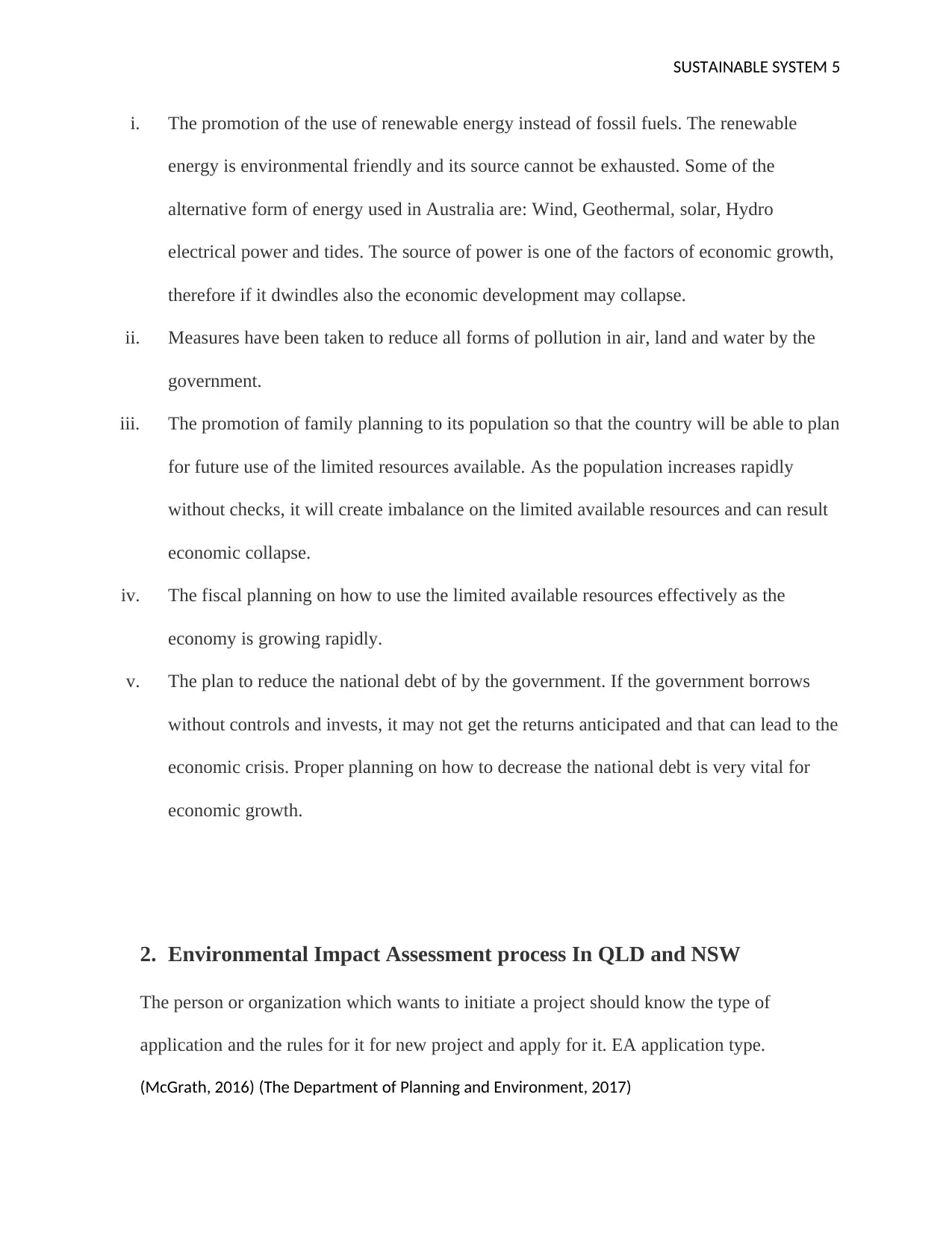
SUSTAINABLE SYSTEM 5
i. The promotion of the use of renewable energy instead of fossil fuels. The renewable
energy is environmental friendly and its source cannot be exhausted. Some of the
alternative form of energy used in Australia are: Wind, Geothermal, solar, Hydro
electrical power and tides. The source of power is one of the factors of economic growth,
therefore if it dwindles also the economic development may collapse.
ii. Measures have been taken to reduce all forms of pollution in air, land and water by the
government.
iii. The promotion of family planning to its population so that the country will be able to plan
for future use of the limited resources available. As the population increases rapidly
without checks, it will create imbalance on the limited available resources and can result
economic collapse.
iv. The fiscal planning on how to use the limited available resources effectively as the
economy is growing rapidly.
v. The plan to reduce the national debt of by the government. If the government borrows
without controls and invests, it may not get the returns anticipated and that can lead to the
economic crisis. Proper planning on how to decrease the national debt is very vital for
economic growth.
2. Environmental Impact Assessment process In QLD and NSW
The person or organization which wants to initiate a project should know the type of
application and the rules for it for new project and apply for it. EA application type.
(McGrath, 2016) (The Department of Planning and Environment, 2017)
i. The promotion of the use of renewable energy instead of fossil fuels. The renewable
energy is environmental friendly and its source cannot be exhausted. Some of the
alternative form of energy used in Australia are: Wind, Geothermal, solar, Hydro
electrical power and tides. The source of power is one of the factors of economic growth,
therefore if it dwindles also the economic development may collapse.
ii. Measures have been taken to reduce all forms of pollution in air, land and water by the
government.
iii. The promotion of family planning to its population so that the country will be able to plan
for future use of the limited resources available. As the population increases rapidly
without checks, it will create imbalance on the limited available resources and can result
economic collapse.
iv. The fiscal planning on how to use the limited available resources effectively as the
economy is growing rapidly.
v. The plan to reduce the national debt of by the government. If the government borrows
without controls and invests, it may not get the returns anticipated and that can lead to the
economic crisis. Proper planning on how to decrease the national debt is very vital for
economic growth.
2. Environmental Impact Assessment process In QLD and NSW
The person or organization which wants to initiate a project should know the type of
application and the rules for it for new project and apply for it. EA application type.
(McGrath, 2016) (The Department of Planning and Environment, 2017)
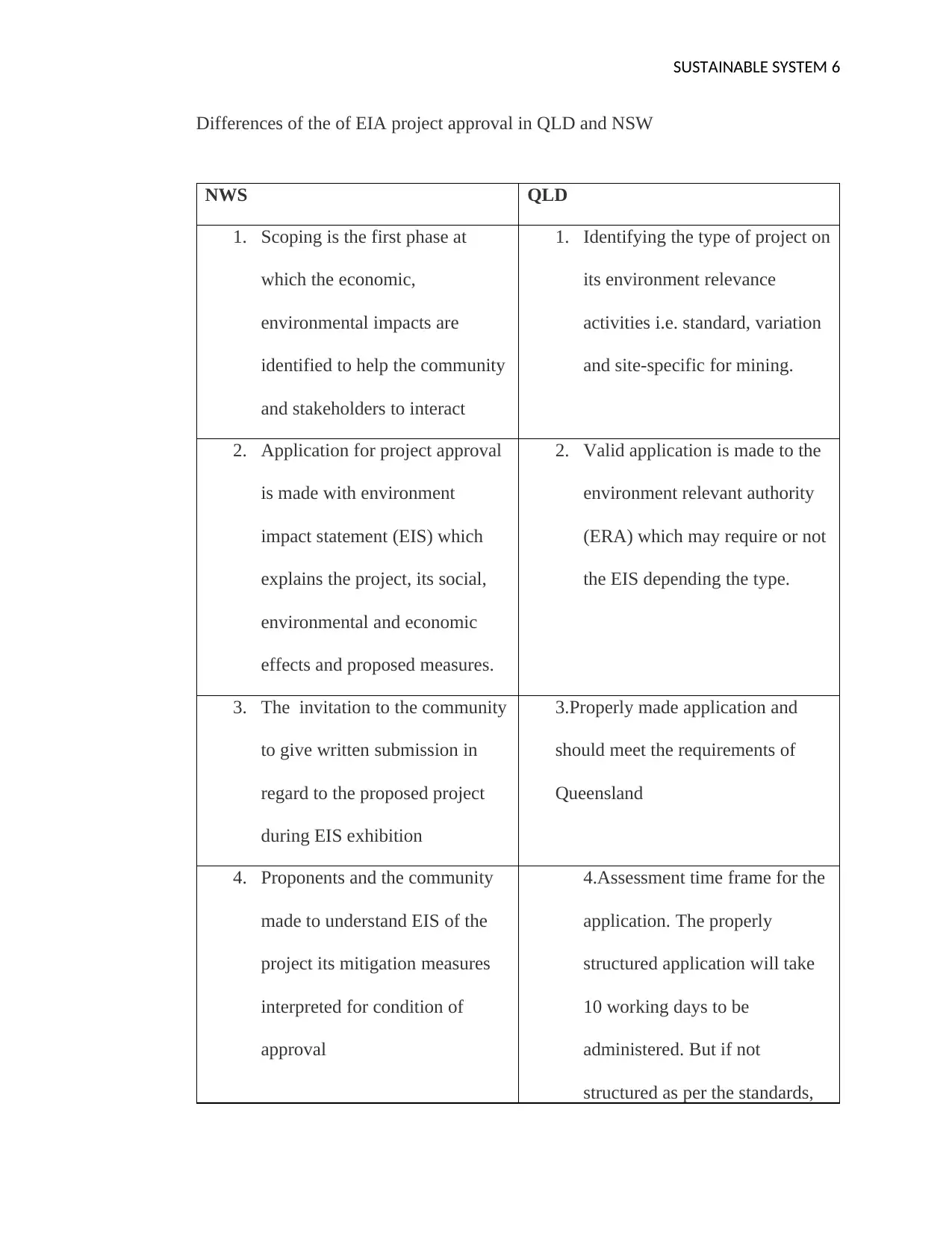
SUSTAINABLE SYSTEM 6
Differences of the of EIA project approval in QLD and NSW
NWS QLD
1. Scoping is the first phase at
which the economic,
environmental impacts are
identified to help the community
and stakeholders to interact
1. Identifying the type of project on
its environment relevance
activities i.e. standard, variation
and site-specific for mining.
2. Application for project approval
is made with environment
impact statement (EIS) which
explains the project, its social,
environmental and economic
effects and proposed measures.
2. Valid application is made to the
environment relevant authority
(ERA) which may require or not
the EIS depending the type.
3. The invitation to the community
to give written submission in
regard to the proposed project
during EIS exhibition
3.Properly made application and
should meet the requirements of
Queensland
4. Proponents and the community
made to understand EIS of the
project its mitigation measures
interpreted for condition of
approval
4.Assessment time frame for the
application. The properly
structured application will take
10 working days to be
administered. But if not
structured as per the standards,
Differences of the of EIA project approval in QLD and NSW
NWS QLD
1. Scoping is the first phase at
which the economic,
environmental impacts are
identified to help the community
and stakeholders to interact
1. Identifying the type of project on
its environment relevance
activities i.e. standard, variation
and site-specific for mining.
2. Application for project approval
is made with environment
impact statement (EIS) which
explains the project, its social,
environmental and economic
effects and proposed measures.
2. Valid application is made to the
environment relevant authority
(ERA) which may require or not
the EIS depending the type.
3. The invitation to the community
to give written submission in
regard to the proposed project
during EIS exhibition
3.Properly made application and
should meet the requirements of
Queensland
4. Proponents and the community
made to understand EIS of the
project its mitigation measures
interpreted for condition of
approval
4.Assessment time frame for the
application. The properly
structured application will take
10 working days to be
administered. But if not
structured as per the standards,
⊘ This is a preview!⊘
Do you want full access?
Subscribe today to unlock all pages.

Trusted by 1+ million students worldwide
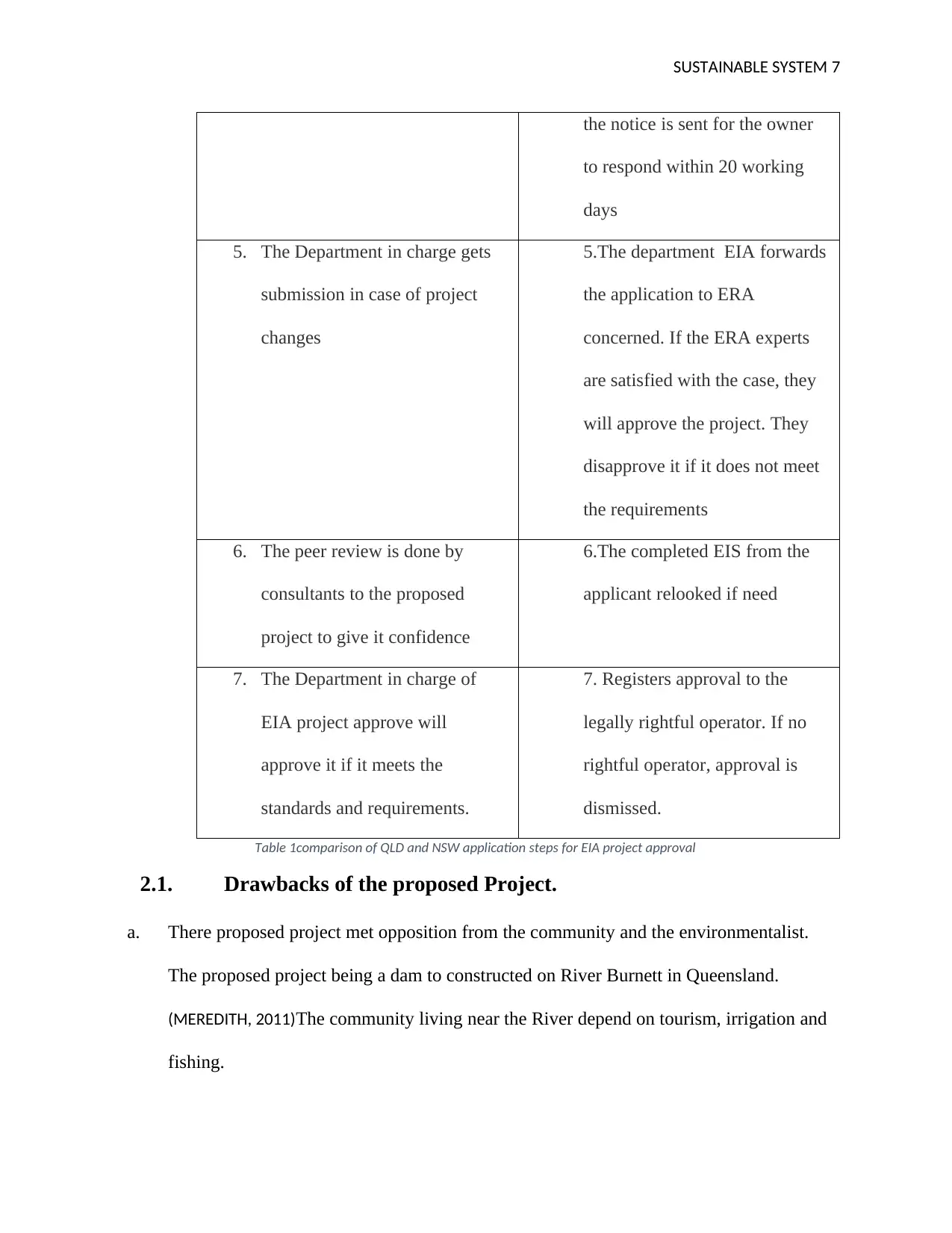
SUSTAINABLE SYSTEM 7
the notice is sent for the owner
to respond within 20 working
days
5. The Department in charge gets
submission in case of project
changes
5.The department EIA forwards
the application to ERA
concerned. If the ERA experts
are satisfied with the case, they
will approve the project. They
disapprove it if it does not meet
the requirements
6. The peer review is done by
consultants to the proposed
project to give it confidence
6.The completed EIS from the
applicant relooked if need
7. The Department in charge of
EIA project approve will
approve it if it meets the
standards and requirements.
7. Registers approval to the
legally rightful operator. If no
rightful operator, approval is
dismissed.
Table 1comparison of QLD and NSW application steps for EIA project approval
2.1. Drawbacks of the proposed Project.
a. There proposed project met opposition from the community and the environmentalist.
The proposed project being a dam to constructed on River Burnett in Queensland.
(MEREDITH, 2011)The community living near the River depend on tourism, irrigation and
fishing.
the notice is sent for the owner
to respond within 20 working
days
5. The Department in charge gets
submission in case of project
changes
5.The department EIA forwards
the application to ERA
concerned. If the ERA experts
are satisfied with the case, they
will approve the project. They
disapprove it if it does not meet
the requirements
6. The peer review is done by
consultants to the proposed
project to give it confidence
6.The completed EIS from the
applicant relooked if need
7. The Department in charge of
EIA project approve will
approve it if it meets the
standards and requirements.
7. Registers approval to the
legally rightful operator. If no
rightful operator, approval is
dismissed.
Table 1comparison of QLD and NSW application steps for EIA project approval
2.1. Drawbacks of the proposed Project.
a. There proposed project met opposition from the community and the environmentalist.
The proposed project being a dam to constructed on River Burnett in Queensland.
(MEREDITH, 2011)The community living near the River depend on tourism, irrigation and
fishing.
Paraphrase This Document
Need a fresh take? Get an instant paraphrase of this document with our AI Paraphraser
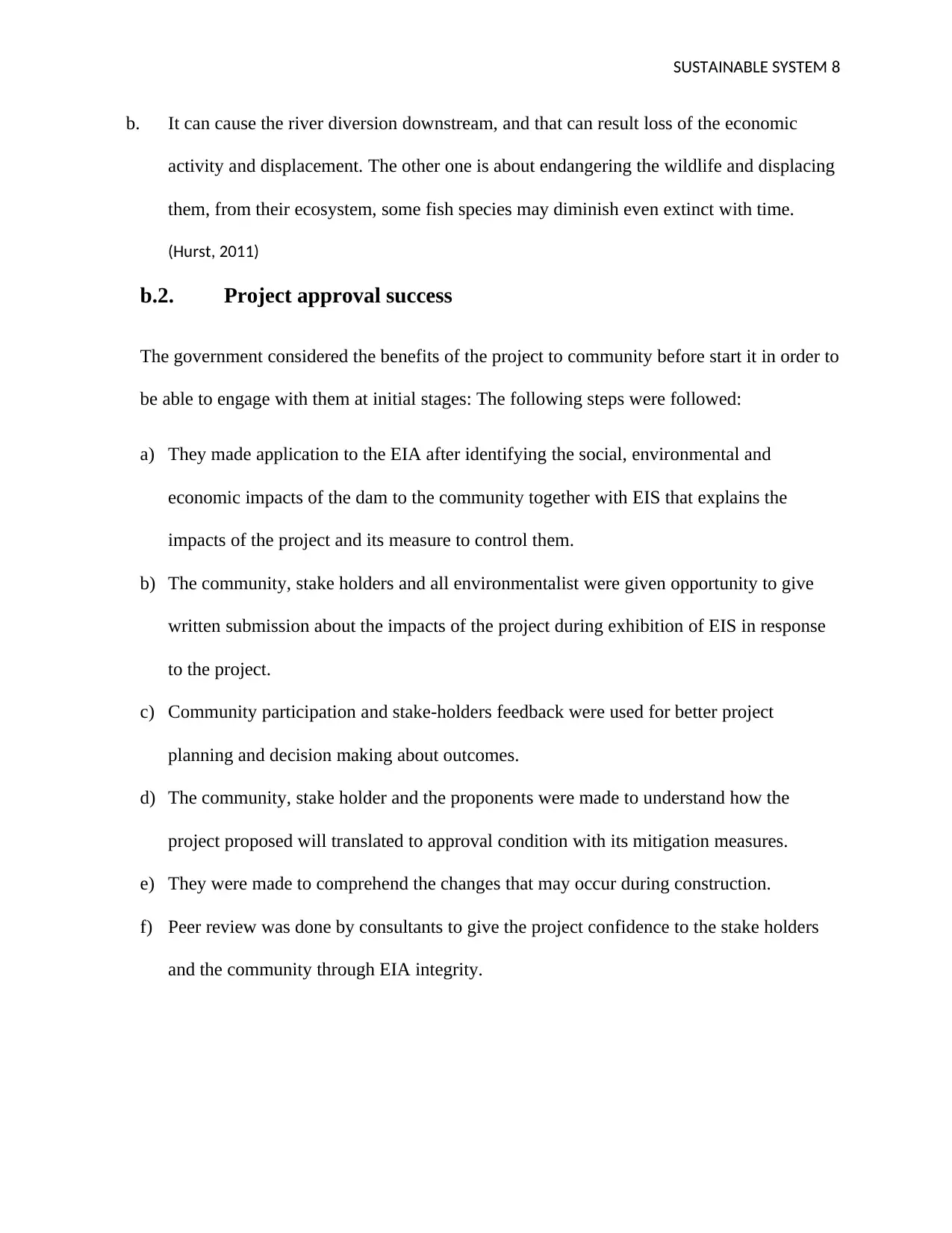
SUSTAINABLE SYSTEM 8
b. It can cause the river diversion downstream, and that can result loss of the economic
activity and displacement. The other one is about endangering the wildlife and displacing
them, from their ecosystem, some fish species may diminish even extinct with time.
(Hurst, 2011)
b.2. Project approval success
The government considered the benefits of the project to community before start it in order to
be able to engage with them at initial stages: The following steps were followed:
a) They made application to the EIA after identifying the social, environmental and
economic impacts of the dam to the community together with EIS that explains the
impacts of the project and its measure to control them.
b) The community, stake holders and all environmentalist were given opportunity to give
written submission about the impacts of the project during exhibition of EIS in response
to the project.
c) Community participation and stake-holders feedback were used for better project
planning and decision making about outcomes.
d) The community, stake holder and the proponents were made to understand how the
project proposed will translated to approval condition with its mitigation measures.
e) They were made to comprehend the changes that may occur during construction.
f) Peer review was done by consultants to give the project confidence to the stake holders
and the community through EIA integrity.
b. It can cause the river diversion downstream, and that can result loss of the economic
activity and displacement. The other one is about endangering the wildlife and displacing
them, from their ecosystem, some fish species may diminish even extinct with time.
(Hurst, 2011)
b.2. Project approval success
The government considered the benefits of the project to community before start it in order to
be able to engage with them at initial stages: The following steps were followed:
a) They made application to the EIA after identifying the social, environmental and
economic impacts of the dam to the community together with EIS that explains the
impacts of the project and its measure to control them.
b) The community, stake holders and all environmentalist were given opportunity to give
written submission about the impacts of the project during exhibition of EIS in response
to the project.
c) Community participation and stake-holders feedback were used for better project
planning and decision making about outcomes.
d) The community, stake holder and the proponents were made to understand how the
project proposed will translated to approval condition with its mitigation measures.
e) They were made to comprehend the changes that may occur during construction.
f) Peer review was done by consultants to give the project confidence to the stake holders
and the community through EIA integrity.
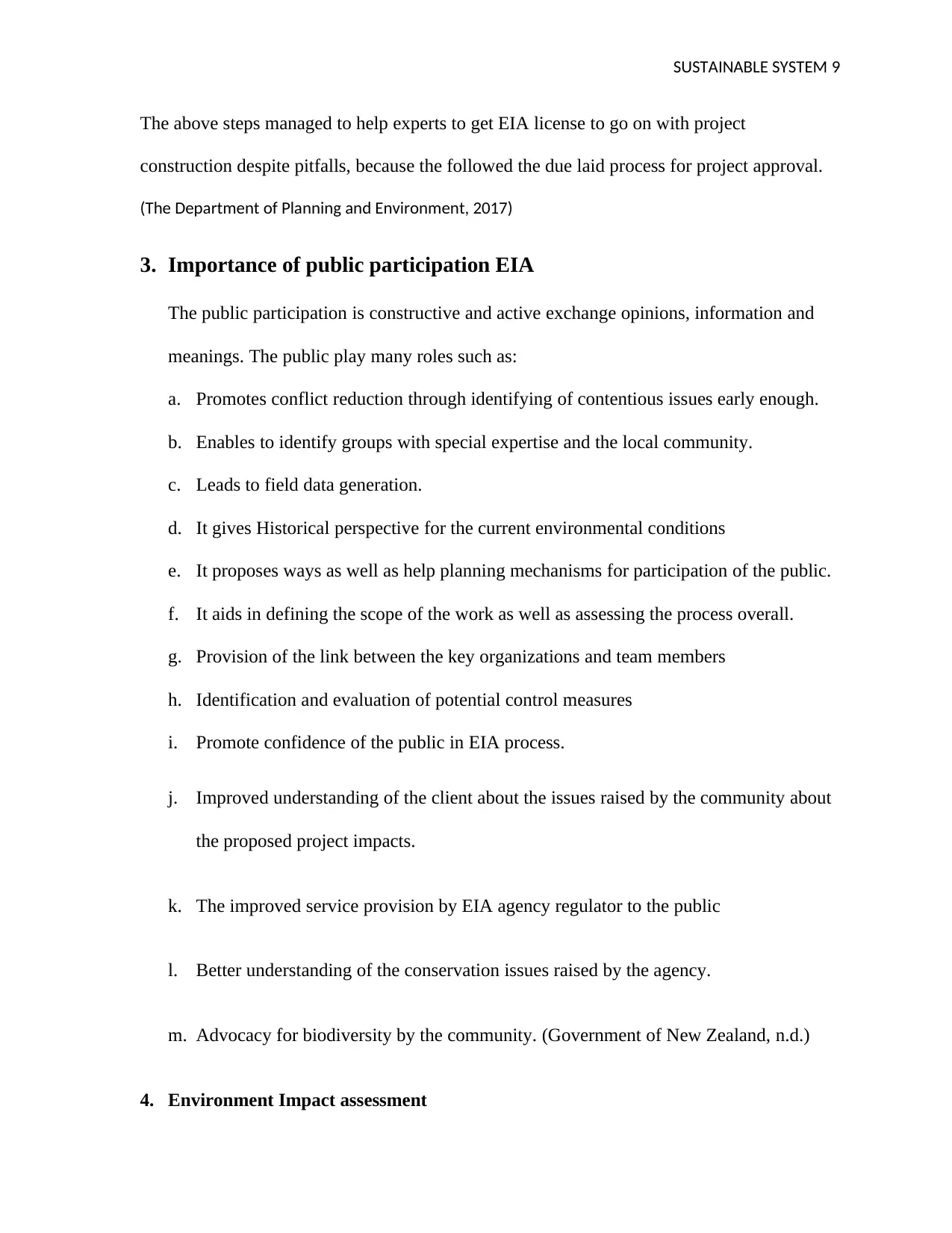
SUSTAINABLE SYSTEM 9
The above steps managed to help experts to get EIA license to go on with project
construction despite pitfalls, because the followed the due laid process for project approval.
(The Department of Planning and Environment, 2017)
3. Importance of public participation EIA
The public participation is constructive and active exchange opinions, information and
meanings. The public play many roles such as:
a. Promotes conflict reduction through identifying of contentious issues early enough.
b. Enables to identify groups with special expertise and the local community.
c. Leads to field data generation.
d. It gives Historical perspective for the current environmental conditions
e. It proposes ways as well as help planning mechanisms for participation of the public.
f. It aids in defining the scope of the work as well as assessing the process overall.
g. Provision of the link between the key organizations and team members
h. Identification and evaluation of potential control measures
i. Promote confidence of the public in EIA process.
j. Improved understanding of the client about the issues raised by the community about
the proposed project impacts.
k. The improved service provision by EIA agency regulator to the public
l. Better understanding of the conservation issues raised by the agency.
m. Advocacy for biodiversity by the community. (Government of New Zealand, n.d.)
4. Environment Impact assessment
The above steps managed to help experts to get EIA license to go on with project
construction despite pitfalls, because the followed the due laid process for project approval.
(The Department of Planning and Environment, 2017)
3. Importance of public participation EIA
The public participation is constructive and active exchange opinions, information and
meanings. The public play many roles such as:
a. Promotes conflict reduction through identifying of contentious issues early enough.
b. Enables to identify groups with special expertise and the local community.
c. Leads to field data generation.
d. It gives Historical perspective for the current environmental conditions
e. It proposes ways as well as help planning mechanisms for participation of the public.
f. It aids in defining the scope of the work as well as assessing the process overall.
g. Provision of the link between the key organizations and team members
h. Identification and evaluation of potential control measures
i. Promote confidence of the public in EIA process.
j. Improved understanding of the client about the issues raised by the community about
the proposed project impacts.
k. The improved service provision by EIA agency regulator to the public
l. Better understanding of the conservation issues raised by the agency.
m. Advocacy for biodiversity by the community. (Government of New Zealand, n.d.)
4. Environment Impact assessment
⊘ This is a preview!⊘
Do you want full access?
Subscribe today to unlock all pages.

Trusted by 1+ million students worldwide
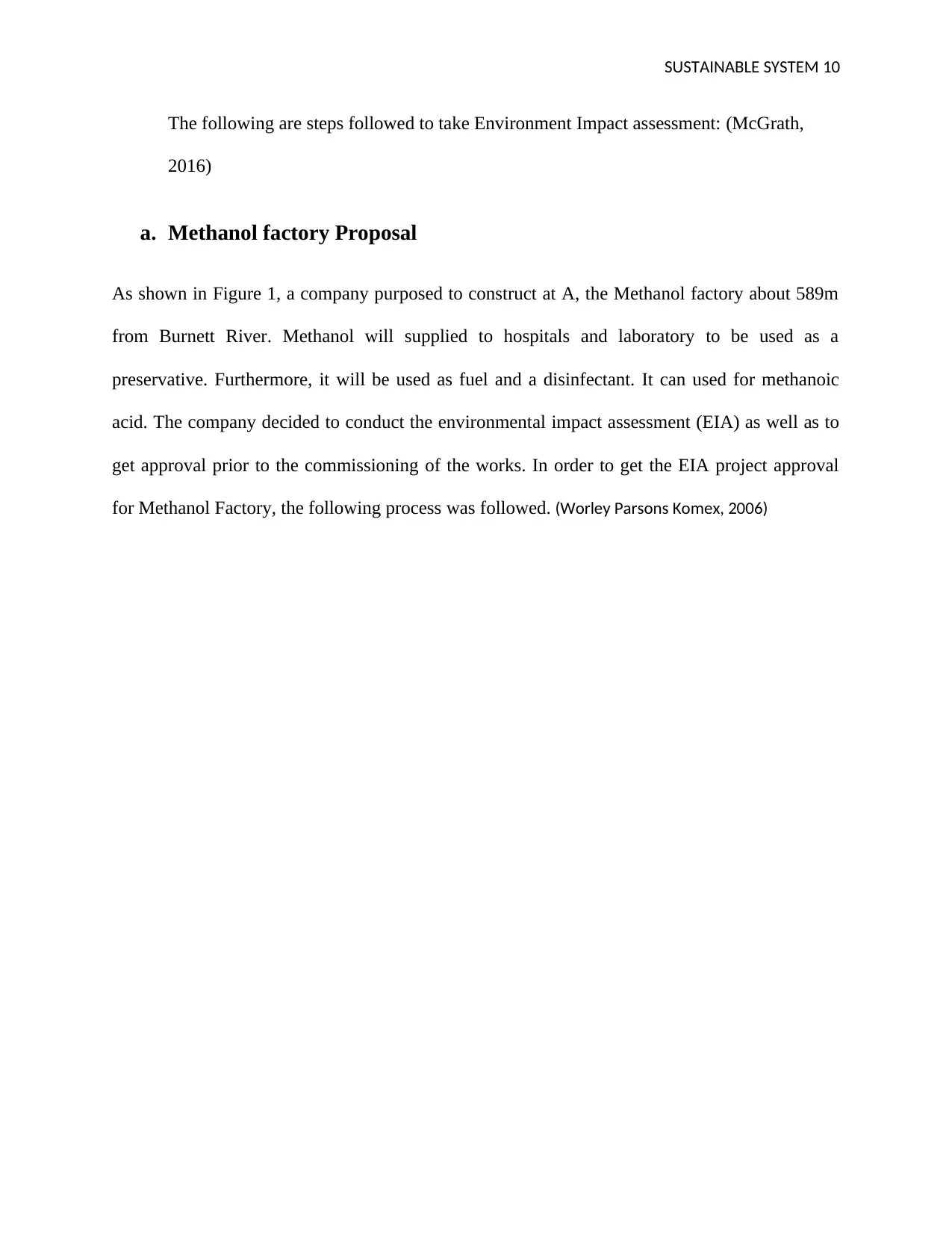
SUSTAINABLE SYSTEM 10
The following are steps followed to take Environment Impact assessment: (McGrath,
2016)
a. Methanol factory Proposal
As shown in Figure 1, a company purposed to construct at A, the Methanol factory about 589m
from Burnett River. Methanol will supplied to hospitals and laboratory to be used as a
preservative. Furthermore, it will be used as fuel and a disinfectant. It can used for methanoic
acid. The company decided to conduct the environmental impact assessment (EIA) as well as to
get approval prior to the commissioning of the works. In order to get the EIA project approval
for Methanol Factory, the following process was followed. (Worley Parsons Komex, 2006)
The following are steps followed to take Environment Impact assessment: (McGrath,
2016)
a. Methanol factory Proposal
As shown in Figure 1, a company purposed to construct at A, the Methanol factory about 589m
from Burnett River. Methanol will supplied to hospitals and laboratory to be used as a
preservative. Furthermore, it will be used as fuel and a disinfectant. It can used for methanoic
acid. The company decided to conduct the environmental impact assessment (EIA) as well as to
get approval prior to the commissioning of the works. In order to get the EIA project approval
for Methanol Factory, the following process was followed. (Worley Parsons Komex, 2006)
Paraphrase This Document
Need a fresh take? Get an instant paraphrase of this document with our AI Paraphraser
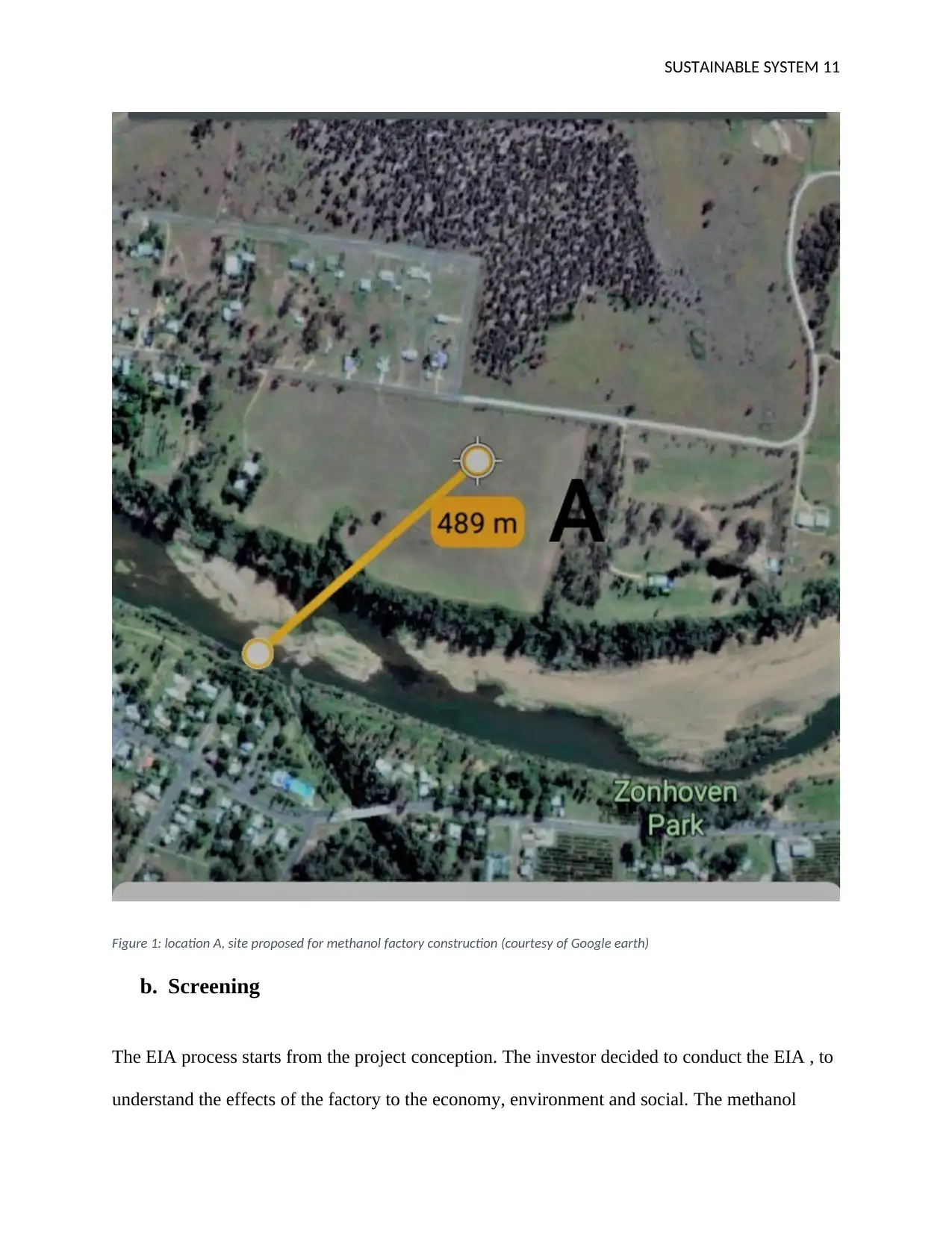
SUSTAINABLE SYSTEM 11
Figure 1: location A, site proposed for methanol factory construction (courtesy of Google earth)
b. Screening
The EIA process starts from the project conception. The investor decided to conduct the EIA , to
understand the effects of the factory to the economy, environment and social. The methanol
Figure 1: location A, site proposed for methanol factory construction (courtesy of Google earth)
b. Screening
The EIA process starts from the project conception. The investor decided to conduct the EIA , to
understand the effects of the factory to the economy, environment and social. The methanol
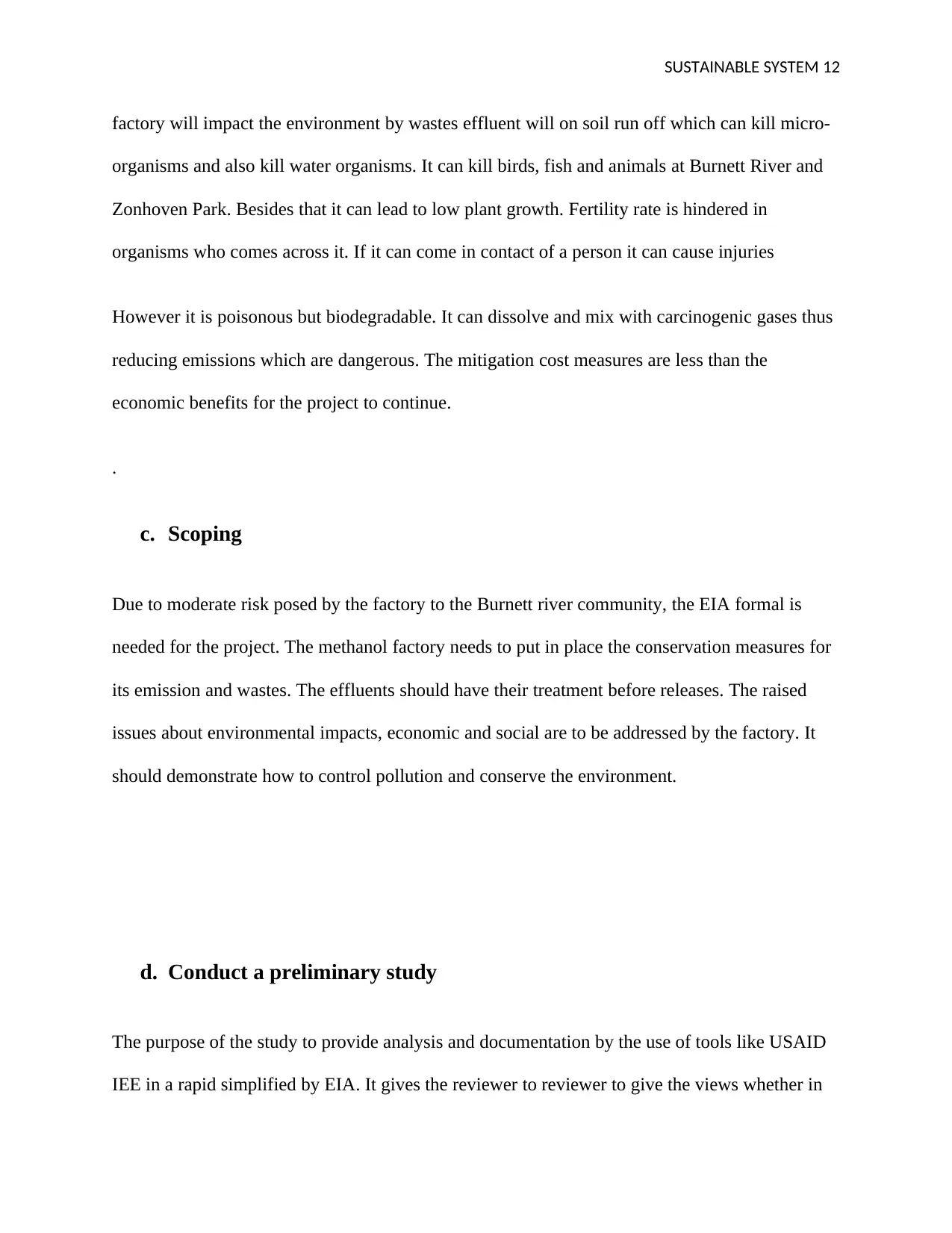
SUSTAINABLE SYSTEM 12
factory will impact the environment by wastes effluent will on soil run off which can kill micro-
organisms and also kill water organisms. It can kill birds, fish and animals at Burnett River and
Zonhoven Park. Besides that it can lead to low plant growth. Fertility rate is hindered in
organisms who comes across it. If it can come in contact of a person it can cause injuries
However it is poisonous but biodegradable. It can dissolve and mix with carcinogenic gases thus
reducing emissions which are dangerous. The mitigation cost measures are less than the
economic benefits for the project to continue.
.
c. Scoping
Due to moderate risk posed by the factory to the Burnett river community, the EIA formal is
needed for the project. The methanol factory needs to put in place the conservation measures for
its emission and wastes. The effluents should have their treatment before releases. The raised
issues about environmental impacts, economic and social are to be addressed by the factory. It
should demonstrate how to control pollution and conserve the environment.
d. Conduct a preliminary study
The purpose of the study to provide analysis and documentation by the use of tools like USAID
IEE in a rapid simplified by EIA. It gives the reviewer to reviewer to give the views whether in
factory will impact the environment by wastes effluent will on soil run off which can kill micro-
organisms and also kill water organisms. It can kill birds, fish and animals at Burnett River and
Zonhoven Park. Besides that it can lead to low plant growth. Fertility rate is hindered in
organisms who comes across it. If it can come in contact of a person it can cause injuries
However it is poisonous but biodegradable. It can dissolve and mix with carcinogenic gases thus
reducing emissions which are dangerous. The mitigation cost measures are less than the
economic benefits for the project to continue.
.
c. Scoping
Due to moderate risk posed by the factory to the Burnett river community, the EIA formal is
needed for the project. The methanol factory needs to put in place the conservation measures for
its emission and wastes. The effluents should have their treatment before releases. The raised
issues about environmental impacts, economic and social are to be addressed by the factory. It
should demonstrate how to control pollution and conserve the environment.
d. Conduct a preliminary study
The purpose of the study to provide analysis and documentation by the use of tools like USAID
IEE in a rapid simplified by EIA. It gives the reviewer to reviewer to give the views whether in
⊘ This is a preview!⊘
Do you want full access?
Subscribe today to unlock all pages.

Trusted by 1+ million students worldwide
1 out of 20
Related Documents
Your All-in-One AI-Powered Toolkit for Academic Success.
+13062052269
info@desklib.com
Available 24*7 on WhatsApp / Email
![[object Object]](/_next/static/media/star-bottom.7253800d.svg)
Unlock your academic potential
Copyright © 2020–2025 A2Z Services. All Rights Reserved. Developed and managed by ZUCOL.





